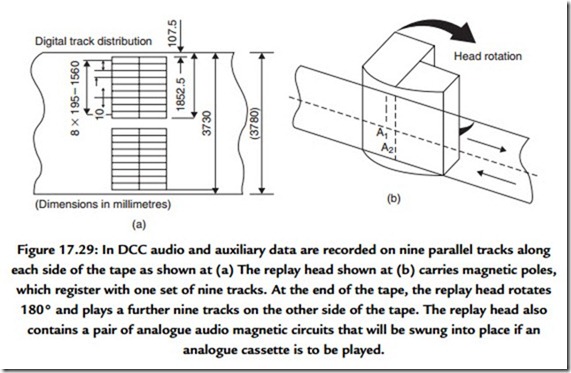Digital Compact Cassette
DCC is a consumer stationary head digital audio recorder using data reduction. Although the convertors at either end of the machine work with PCM data, these data are not directly recorded, but are reduced to one-quarter of their normal rate by processing. This allows a reasonable tape consumption similar to that achieved by a rotary head recorder. In a sense, the complexity of the rotary head transport has been exchanged for the electronic complexity of the data reduction and subsequent expansion circuitry.
Figure 17.29 shows that DCC uses stationary heads in a conventional tape transport that can also play analogue cassettes. Data are distributed over nine parallel tracks, which occupy half the width of the tape. At the end of the tape the head rotates about an axis perpendicular to the tape and plays the other nine tracks in reverse. The advantage of the conventional approach with linear tracks is that tape duplication can be carried out at high speed. This makes DCC attractive to record companies.
However, reducing the data rate to one-quarter and then distributing it over nine tracks means that the frequency recorded on each track is only about 1/32 that of a PCM
machine with a single head. At such a low frequency, conventional inductive heads that generate a voltage from flux changes cannot be used, and DCC has to use active heads that actually measure the flux on the tape at any speed. These magneto-resistive heads are more complex than conventional inductive heads and have only recently become economic as manufacturing techniques have been developed.
Data reduction relies on the phenomenon of auditory masking and this effectively restricts DCC to being a consumer format. It will be seen from Figure 17.30 that the data reduction unit adjacent to the input is complemented by the expansion unit or decoder prior to the DAC. The sound quality of a DCC machine is not a function of the tape, but depends on the convertors and on the sophistication of the data reduction and expansion units.
